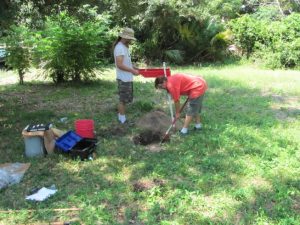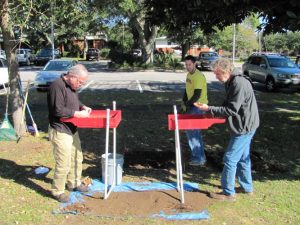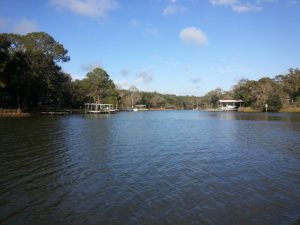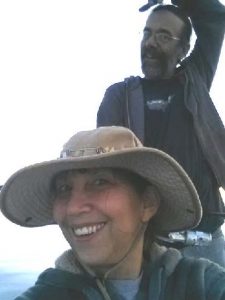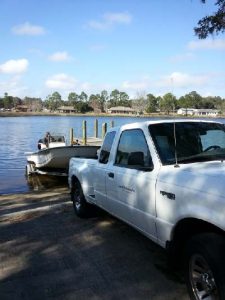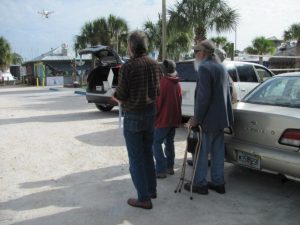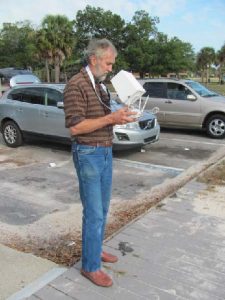``The Spanish King's Finest Jewel``
Bayou Chico on the Bay of Pensacola
by Caleb Curren and David Dodson
Contact Archeology Inc.
ArcheologyInk.com: an Online Journal, March 2017
A brilliant Mexican mathematician, scientist, and priest visited Bayou Chico on Pensacola Bay in 1693. The good Rev. Dr. Carlos de Siguenza y Gongora was sent to map Pensacola Bay by the King of Spain and the Viceroy of Mexico. During his cartographic research, Siguenza was overcome by the beauty of a body of water off the bay that is known today known as Bayou Chico. He pronounced it the most beautiful place in all of the Spanish Empire. The scientist of the king stated that Bayou Chico was:
“… the finest jewel possessed by his Majesty … not only here in America but in all his kingdom.”
That was, indeed, a bold statement. At the time, the Spanish Empire spanned three oceans and portions of three continents. Apparently, today’s Bayou Chico was, in the 1600s, an extraordinarily beautiful place in the eyes of the Professor Siguenza.
Due to those early historical high praises of Bayou Chico, a local research and education group known as Contact Archeology Inc. has organized an archeological and historical research project focused on this “Spanish King’s Finest Jewel.” The study is focused on the early history of Bayou Chico dating from the 1500s through the early 1800s. The historic cultures include Native Aboriginals, Spanish, French, British, and American.
The Bayou Chico research involves six primary strategies. They are:
1. Contact local people with knowledge of bayou lore and artifact collections.
2. Conduct archeological test excavation on selected properties on the bayou.
3. Analyze historic documents and maps relative to the early history of the bayou.
4. Compile an archive of historic images of the bayou.
5. Map sources of freshwater springs in the bayou area.
6. Conduct underwater remote sensing surveys in the bayou and adjacent bay areas.
We know that Bayou Chico is rich in history. Native peoples lived there when the first Spanish explorers ar-rived in the 1500s. Professor Siguenza of the 1693 Spanish Expedition visited Bayou Chico and produced writings and a detailed map. A French priest spied on the Spanish during his time spent on Pensacola Bay in 1717 and produced documents and a map describing “ruins of a fort” on Bayou Chico. Those fort ruins could have been associated with the Spanish Luna Expedition of 1559. Spanish General Galvez and his army, at least 7,000 strong, encamped on the bayou in his successful bid to retake Pensacola from the British in 1781 during the American Revolution. American General Andrew Jackson with his army of some 3,000 camped on the bayou in 1814 during his attack on the Spanish army in Pensacola. Bayou Chico was certainly a consistently desirable area of settlement during the early historic period based on abundant freshwater springs, elevation, and strategic proximity to the entrance of Pensacola Bay.
The current research project conducted by Contact Archeology Inc. is the first such project focused solely on the Bayou Chico area. The project is funded through tax deductible sponsorships from individuals and corporations interested in this unique research exploration on Pensacola Bay. The following page provides information for sponsors. The last page provides a sample of field photographs of our work in the Bayou Chico area.
An Exploration of the Early History of Bayou Chico
on Pensacola Bay
(Information for Sponsors)
______________________
Contact Archeology Inc.
A Research and Education Non-Profit Corporation
P.O. Box 30576
Pensacola, Florida 32503
850-982-5251
___________________
If you, your family, or your business would like to become a Sponsor of this unique archeological and historical research project, you are encouraged to send your sponsorship check to the address provided above. The sponsorship is tax deductible. Sponsors can refer to our website (ArcheologyInk.com) for postings of our ongoing research. Details of the Contact Archeology Inc. research group can also be accessed on our website.
- Article
-
ArcheologyInk.com: an Online Journal, March 2017
A brilliant Mexican mathematician, scientist, and priest visited Bayou Chico on Pensacola Bay in 1693. The good Rev. Dr. Carlos de Siguenza y Gongora was sent to map Pensacola Bay by the King of Spain and the Viceroy of Mexico. During his cartographic research, Siguenza was overcome by the beauty of a body of water off the bay that is known today known as Bayou Chico. He pronounced it the most beautiful place in all of the Spanish Empire. The scientist of the king stated that Bayou Chico was:
“… the finest jewel possessed by his Majesty … not only here in America but in all his kingdom.”
That was, indeed, a bold statement. At the time, the Spanish Empire spanned three oceans and portions of three continents. Apparently, today’s Bayou Chico was, in the 1600s, an extraordinarily beautiful place in the eyes of the Professor Siguenza.
Due to those early historical high praises of Bayou Chico, a local research and education group known as Contact Archeology Inc. has organized an archeological and historical research project focused on this “Spanish King’s Finest Jewel.” The study is focused on the early history of Bayou Chico dating from the 1500s through the early 1800s. The historic cultures include Native Aboriginals, Spanish, French, British, and American.
The Bayou Chico research involves six primary strategies. They are:1. Contact local people with knowledge of bayou lore and artifact collections.
2. Conduct archeological test excavation on selected properties on the bayou.
3. Analyze historic documents and maps relative to the early history of the bayou.
4. Compile an archive of historic images of the bayou.
5. Map sources of freshwater springs in the bayou area.
6. Conduct underwater remote sensing surveys in the bayou and adjacent bay areas.We know that Bayou Chico is rich in history. Native peoples lived there when the first Spanish explorers ar-rived in the 1500s. Professor Siguenza of the 1693 Spanish Expedition visited Bayou Chico and produced writings and a detailed map. A French priest spied on the Spanish during his time spent on Pensacola Bay in 1717 and produced documents and a map describing “ruins of a fort” on Bayou Chico. Those fort ruins could have been associated with the Spanish Luna Expedition of 1559. Spanish General Galvez and his army, at least 7,000 strong, encamped on the bayou in his successful bid to retake Pensacola from the British in 1781 during the American Revolution. American General Andrew Jackson with his army of some 3,000 camped on the bayou in 1814 during his attack on the Spanish army in Pensacola. Bayou Chico was certainly a consistently desirable area of settlement during the early historic period based on abundant freshwater springs, elevation, and strategic proximity to the entrance of Pensacola Bay.
The current research project conducted by Contact Archeology Inc. is the first such project focused solely on the Bayou Chico area. The project is funded through tax deductible sponsorships from individuals and corporations interested in this unique research exploration on Pensacola Bay. The following page provides information for sponsors. The last page provides a sample of field photographs of our work in the Bayou Chico area.An Exploration of the Early History of Bayou Chico
on Pensacola Bay
(Information for Sponsors)
______________________
Contact Archeology Inc.
A Research and Education Non-Profit Corporation
P.O. Box 30576
Pensacola, Florida 32503
850-982-5251
___________________
If you, your family, or your business would like to become a Sponsor of this unique archeological and historical research project, you are encouraged to send your sponsorship check to the address provided above. The sponsorship is tax deductible. Sponsors can refer to our website (ArcheologyInk.com) for postings of our ongoing research. Details of the Contact Archeology Inc. research group can also be accessed on our website.
- Download PDF Version
